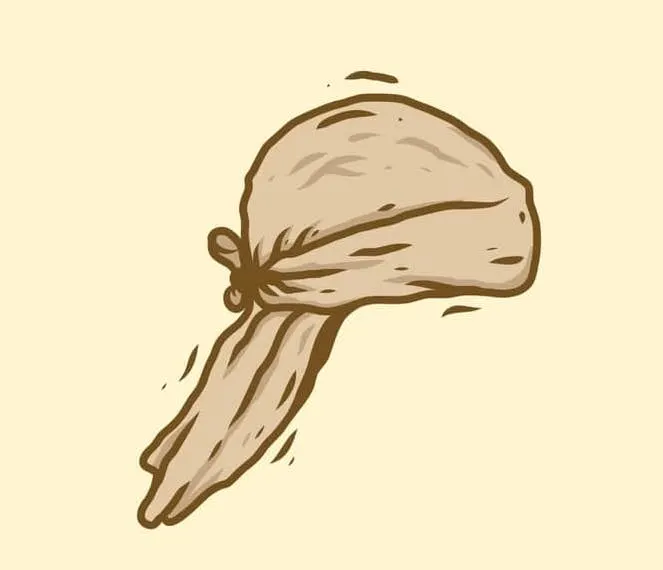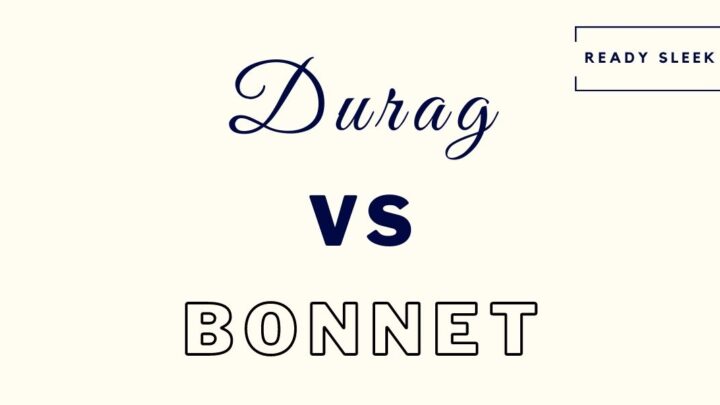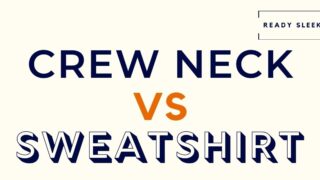The durag and the bonnet are both titans when it comes to hair care and styling. But how do you decide between the two?
Durags are more form-fitting than bonnets and are useful for maintaining hairstyles where compression is important, such as 360 waves. Bonnets do not compress hair but are better at retaining moisture, so are useful for curly hair and afros.
We will get into this in more detail in this article.
But first, let’s discuss the key differences and similarities between the durag and the bonnet, then we can discuss the situations when you might decide to choose one over the other.
Durag Vs Bonnet: 3 Differences
The main difference between durags and bonnets is the shape of the cloth and how you put it on. This affects how they work on the hair differently when worn.
Let’s discuss this in more detail.
1. Shape
Durags have a distinctive shape that allows them to be worn in a way that fits closely to the shape of the scalp.
They usually have a flap covering the neck and ties at the back of the head so that they can be secured in place.

Image From Deposit Photos
Here’s a durags on

Bonnets, on the other hand, are much less form-fitting than durags, and often have an elastic rim that is used to secure it in place.
Some bonnets have a drawstring adjustable rim which allows you to adjust the bonnet to your head size.
Here’s an example of a bonnet on

Bonnets don’t put as much pressure on hair compared with durags, allowing the hair more room to sit naturally.
2. Layering
Durags are typically made out of a single layer of fabric that is slightly stretchy, so when tied it allows a snug fit to the head.
Bonnets, although some will come in single-layer fabric, can also be found in a double-layer form.
Double layered bonnets can be especially good at locking in moisture to the hair when worn.
This feature of bonnets is important when it comes to considering which of these types of headwear to use in your hair care routine, and we’ll discuss this more below.
3. Aesthetic
Nowadays, you can find both durags and bonnets in a multitude of different colors and patterns to suit your taste.
Most people tend to see bonnets as ‘indoor’ wear, however, and usually reserve them for use in the home.
Durags, on the other hand, are often seen as a style item and are routinely worn outdoors as well as indoors.
As fashion trends evolve, more people are now wearing bonnets as a style item too, though this still tends to be less common.
So in terms of aesthetics, durags come out on top.
2 Similarities Between Durags and Bonnets
Other than the obvious similarity of both being types of headwear used for hairstyling and protection, there are a couple of other similarities that it’s worth pointing out when it comes to durags and bonnets.
1. Material
Both durags and bonnets can be found in satin or silk materials, which are the best materials to choose from when it comes to hair care.
Satin and silk snag less than cotton, for example, meaning that your hair is safer from breakage and frizz with these materials.
You can also get durags in other materials, but when it comes to hair protection silk or satin is recommended.
2. Price
One great similarity between these two types of headwear is that they can both be obtained at reasonable prices.
If sourced online, both durags and bonnets can be actually found very cheaply.
This means that having one of each in your wardrobe is a real option for most people, which is good because durags and bonnets have different benefits when it comes to hair protection and styling.
Durag Vs Bonnet For Specific Hair Styles
Hopefully discussing the differences and similarities between durags and bonnets has given you a clearer idea of what these types of headwear look like and how they’re worn.
But when should you choose to wear a durag over a bonnet and vice versa?
Hairstyles that require more compression such as the 360 waves are better served by a durag, whereas for hairstyles such as curls or afros it is better to wear a bonnet.
Therefore, the choice to wear a durag or a bonnet very much depends on the type of hairstyle you have.
Let’s go through this in more detail for the most common hairstyles.
Durag Or Bonnet For Curly Hair
Bonnets are better than durags for maintaining curly hair because they do not compress your hair and therefore keep the curls intact.
Because bonnets can be double-layered, they are also very good at locking in moisture to your hair. This keeps curls well defined, helps to reduce frizz, and ensures your hair stays hydrated.
If you apply hair oil before putting on your bonnet, this will allow the hair oil to really get to work as the bonnet stops it from leaching out of your hair.
Durags, on the other hand, have too much of a compression effect to be suitable for curly hair. This compression can risk ruining or flattening your curls.
So if you are looking to take care of your naturally curly hair, a bonnet is preferable.
Durag Or Bonnet For An Afro
Bonnets are better than durags for maintaining an afro hairstyle, as they do not compress your hair and allow you to maintain volume.
If you have an afro, you know that volume is important. Bonnets are better than durags at maintaining this volume because they do not compress the hair.
Even though they don’t have a compression effect, bonnets still prevent excessive hair movement, especially if worn at night.
Tossing and turning can lead to hair breakage, and bonnets are effective at preventing this.
So unless you want a flat afro, a bonnet is going to be your best bet when it comes to looking after your hair.
Durag Or Bonnet For Dreads
Both bonnets and durags are suitable for maintaining dreads. Bonnets are very effective at keeping dreads moisturized and protected from breakage. Durags are useful in training dreads to lay the way you want them to.
A bonnet can fully cover your locs and hence prevent breakage and moisture loss overnight.
On the other hand, durags can offer the compression needed to train your hair to lay how you want it to at the scalp, whilst also giving some coverage to the ends of your hair with the neck flap.
Both options can be used for maintaining locs.
Some people choose to wear bonnets if they are spending the day at home, as bonnets are more effective than durags at retaining your hair’s moisture.
They might then choose to swap this for a durag at night to help with training the dreads, or if they want to go out during the day and prefer the durag aesthetic.
Essentially, if you have dreads, it’s worth investing in both a bonnet and a durag.
Durag Or Bonnet For Cornrows
Instead of using one or the other, durags and bonnets can be worn together for extra hair protection and moisture retention when sleeping with cornrows.
Cornrows are a great hairstyle, but any type of braids style is unfortunately vulnerable to damage and fraying at night.
As a result, people have developed several ways to protect this hairstyle.
The most common method is to wrap your braids in a silk scarf or a durag after you’ve moisturized your hair and scalp.
For additional protection, you can wear a silk or satin bonnet on top of this.
This is a foolproof way to keep moisture locked into those cornrows, which is extremely important to keep the braids intact and well defined.
If you want to go the extra mile and be sure that you won’t end up with damaged or frizzy cornrows, you can even invest in a silk pillowcase.
That way, even if a braid gets loose at night when you’re tossing and turning, you won’t need to worry.
Durag Or Bonnet For Twists
Bonnets are better than durags for twists, as they can retain moisture without compressing the hair and flattening the individual twists.
It can take a lot of work to achieve the twists style, so most people want to make it last as long as possible.
A bonnet is better in this situation because twists risk being flattened by the compression effect of the durag.
Bonnets will give the twists some breathing space, allowing them to retain their volume whilst also keeping the hair hydrated and protected against frizzing.
Some people choose to wear a silk scarf if they don’t have a bonnet to hand. But the intent with both options is similar – to retain volume as well as moisture.
Durag Or Bonnet For Waves
To achieve and maintain the 360 waves look, you need headwear that will give a compression effect. Durags are able to compress hair as they fit snugly to the scalp, and therefore are ideal for getting waves.
Durags are an essential part of the process of spinning waves, so they are the obvious choice for this hairstyle.
They work by preserving the brushing of your hair and also keeping your waves in place.
Bonnets don’t have the same compression effect on your hair that durags do, so they aren’t used for the 360 waves style.
Durag Or Bonnet For Straightened Hair
Both durags and bonnets are useful when it comes to straightened hair. Durags can be useful for keeping hair straight and under control during the day, whereas bonnets are effective at protecting straight hair if worn when sleeping.
Getting your hair straightened often involves a fair amount of chemicals and heat styling.
Many people, therefore, wish to keep their hair as straight as possible so that they don’t need to repeat the straightening process too often.
Durags, with their form-fitting design, are effective at keeping straight hair in place and from getting too tangled. This can be useful if you’re out and about and active during the day.
During the night, however, using a bonnet will help to keep treated hair hydrated and protected against breakage.
Putting on a bonnet over straight hair that has been wrapped around your head and secured with bobby pins is an effective way to do this, whilst also keeping hair kink-free.
Conclusion
Both durags and bonnets are staples when it comes to hair maintenance and styling, and how to choose between them depends on your choice of hairstyle.
Hopefully, by reading this article you feel more confident about knowing when to choose between them, and in some situations, when to use them together.
Ready Sleek founder. Obsessed with casual style and the minimalist approach to building a highly functional wardrobe. Also a fan of classic, vintage hairstyles.







